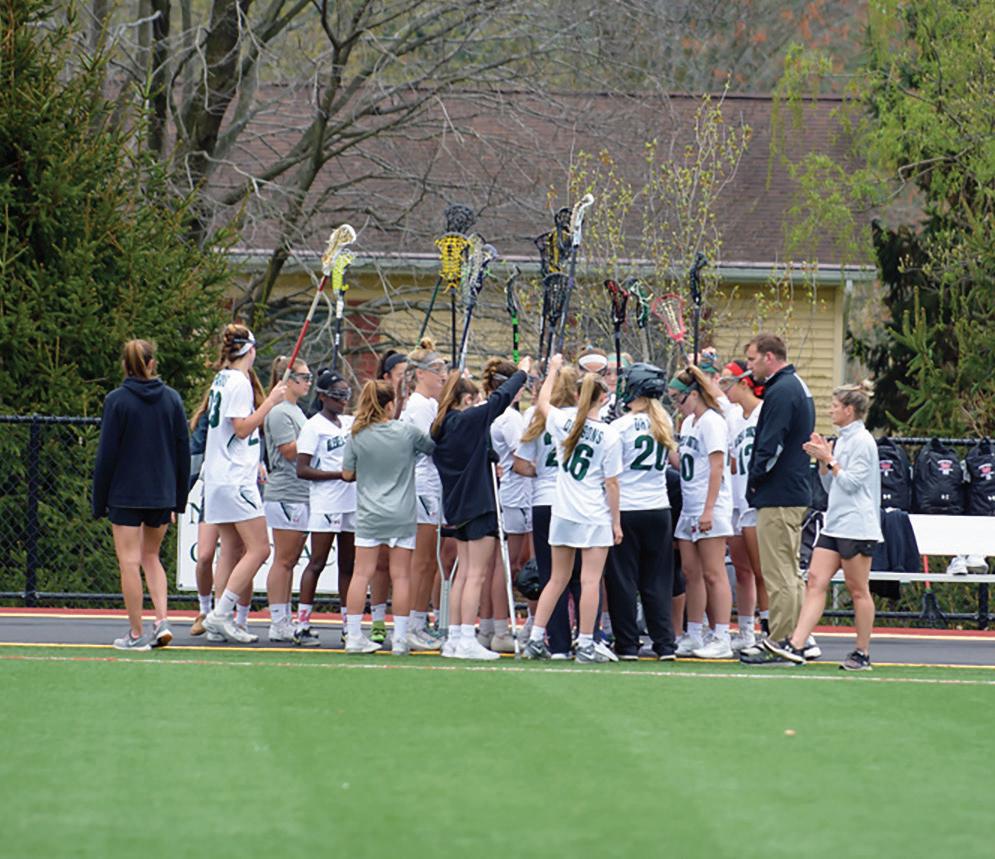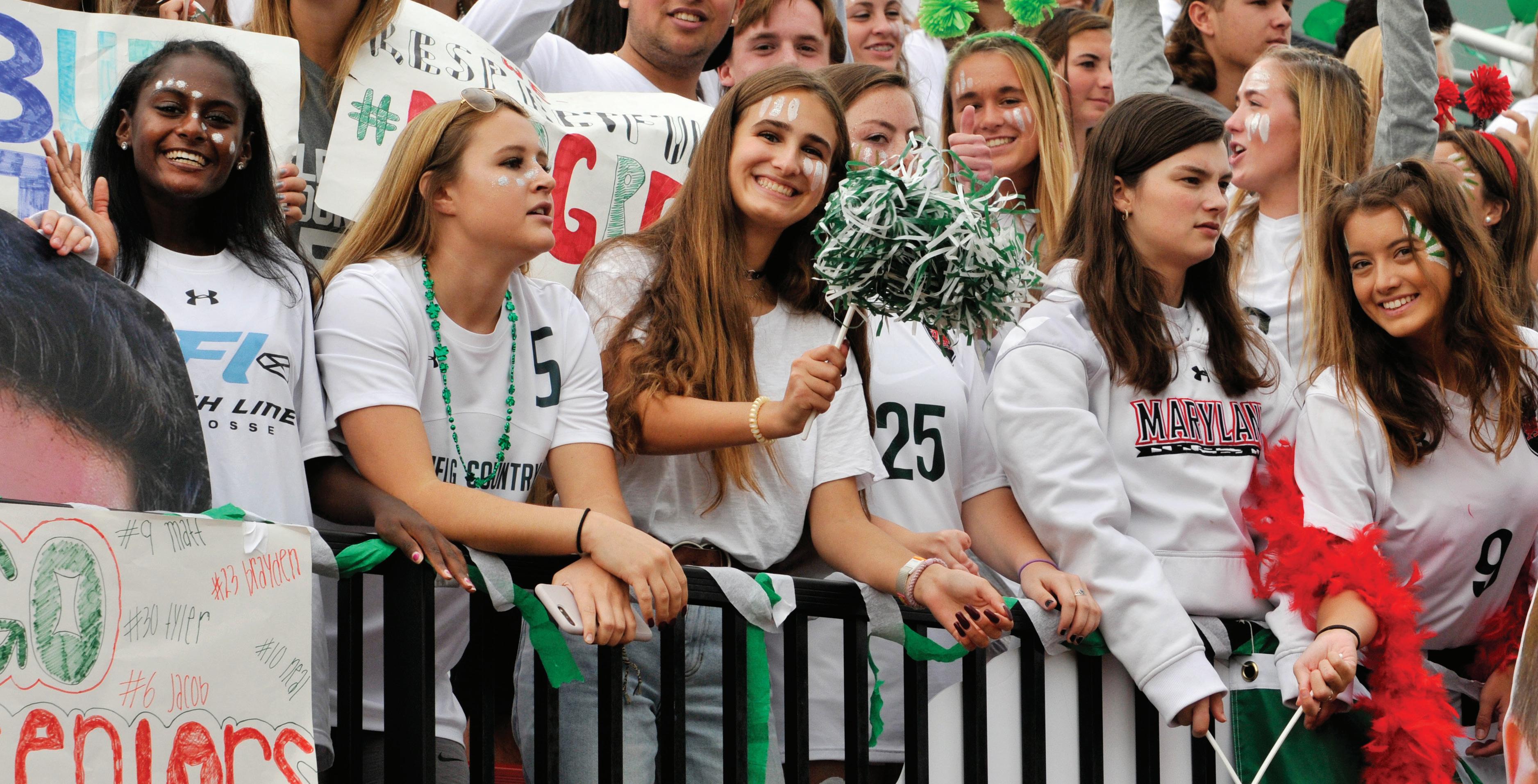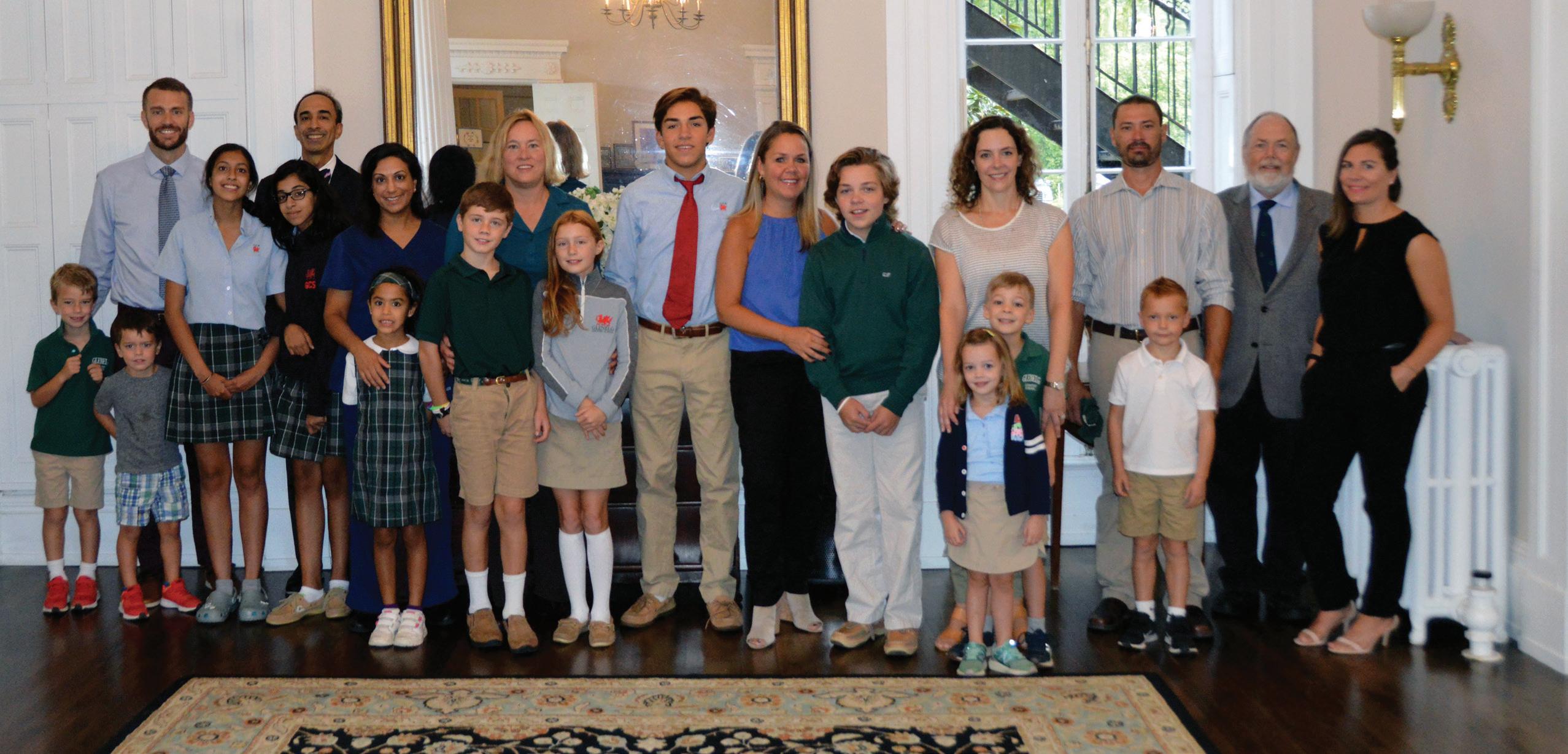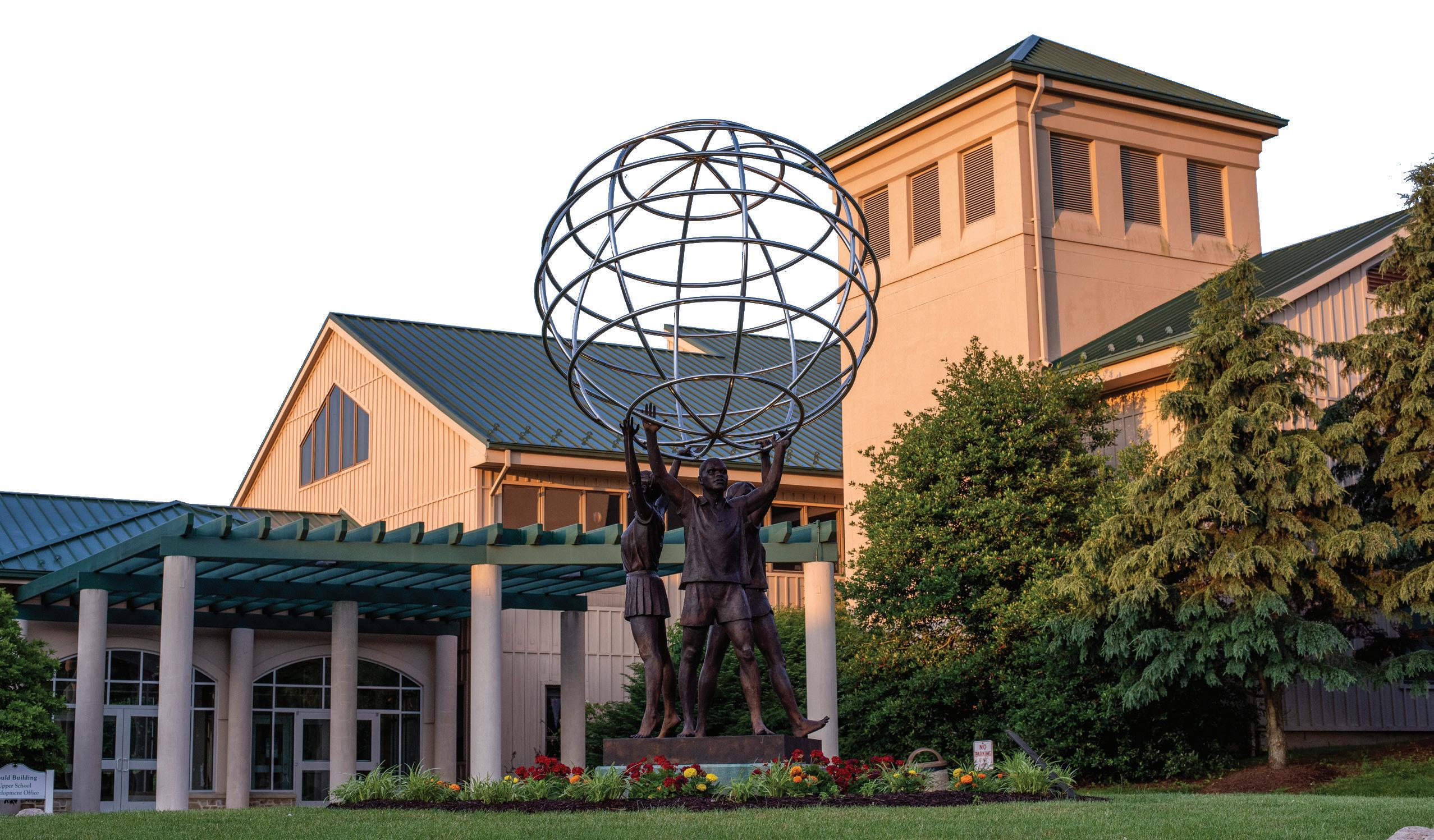
24 minute read
LOWER SCHOOL
By Kirsten Mahoney DIRECTOR OF LITTLE DRAGONS AND YOUTH AND MEMBERSHIP PROGRAMS
John Dewey U.S. PHILOSOPHER AND EDUCATOR
In 2012, I had a vision. A spark. An idea. I was a new parent of a one-year-old who wanted something more for my child. I looked around the Glenelg Country School (GCS) campus and thought, “I want this for my child. I want a community for him. I want a place of true learning for him. I want him to be here with me.” Then, I met another teacher, Scott Proffitt, Upper School Latin teacher, who also had a vision. He wanted the same thing for his child too. We came together to create something not only for our children but for our whole community. We were given this opportunity through a Professional Development Day called “FedEx Day.” These are “one-day bursts of autonomy that allow people to work on anything they want, as long as it is not part of their regular job, provided they show what they’ve created to their colleagues 24 hours later.” My background in education includes degrees in elementary education and leadership with specializations in early childhood development and leadership in school, family, and community collaboration. During my time in college and my teaching experience, I studied and experienced a variety of philosophies and approaches to education. The one I believe in and matched with the GCS mission was the Reggio Emilia approach, a pedagogy that is student-centered and constructivist that uses self-directed, experiential learning in relationship-driven environments. I shared this approach with Mr. Proffitt as an idea for our program. I handed him a lengthy book to read, The Hundred Languages of Children: The Reggio Emilia Experience in Transformation. From that point, the foundation of the program began to take shape.
In 2013, Mr. Proffitt and I spent time working on developing our vision of a possible early education center on campus. We sent a survey to the GCS faculty and staff to see if others shared in our idea of offering something for our young children on the campus. The response was overwhelming. More than half the employees completed the survey on the first day, affirming support of our vision. After researching independent schools in the area that offered early childhood education programs, we honed in on what made an excellent early education program at an independent school like GCS, and our vision to include something that matched the school’s mission was made more clear.
Facing page: Lily Clark ’35, Sophia Marotta ’35, and Jack Gong ’35 Below: Hazel Weeks ’35, Thomas Dolan ’35, and Parker Nelson ’35
If GCS had an early education center, would you be interested in having your child enrolled here?

YES
NO




The Hundred Languages of Children
No way. The hundred is there. The child is made of one hundred. The child has a hundred languages a hundred hands a hundred thoughts a hundred ways of thinking of playing, of speaking. a hundred, always a hundred ways of listening of marveling, of loving a hundred joys for singing and understanding a hundred worlds to discover a hundred worlds to invent a hundred worlds to dream. The child has a hundred languages (and a hundred hundred hundred more) but they steal ninety-nine. The school and the culture separate the head from the body. They tell the child to think without hands to do without head to listen and not to speak to understand without joy to love and to marvel only at Easter and Christmas. They tell the child to discover the world already there and of the hundred they steal ninety-nine. They tell the child that work and play reality and fantasy science and imagination sky and earth reason and dream are things that do not belong together. And thus they tell the child that the hundred is not there. The child says “No way – The hundred is there.”
By the fall of 2014, we received approval to move forward with the program, starting with the addition of a two-yearold program and incorporating the current three-year-old program. With guidance and support from Greg Ventre, head of school; Jhan Tangires, chief financial officer; the Office of Admission; and the newly formed Lower School administrative team comprised of Anne Wooleyhand, Hilary McCarthy, and myself, we immediately began working on finalizing details. We also finally had the name of our program: The Little Dragons.
At the time, I had never been to Italy to study the Reggio Emilia schools. I had read books and attended local workshops and conferences. I reached out to my contacts who had journeyed to the world-renowned schools and decided to participate in a weekend conference about the Reggio Emilia approach in West Virginia. Laurie Shapiro, the Primary Building Art Studio teacher, also attended. It was during this conference that she and I started making plans to see the method ourselves in Italy.
In the spring of 2015, Mrs. Shapiro and I found ourselves in Reggio Emilia, Italy, and Pistoia, Italy, to study their approach to early childhood education. Our motto for that trip was “Nothing Without Joy,” which is a quote taken from Loris Malaguzzi, founder of the Reggio schools. We returned to GCS inspired and joyful, ready to open the doors of Little Dragons. Reading “The Hundred Languages of Children” poem by Loris Malaguzzi, inspired our work as we looked for ways to bring the poem to life. That summer, we offered teacher workshops focused on the elements of the Reggio Emilia approach, designed classroom spaces, worked on student documentation, and truly began our journey of transforming our methodology in working with the youngest learners on campus, a journey that continues to this day.
A few years into the program, demand had grown, and we added another section of the three-year-old class, giving us a total of five homerooms. As the program grew, we continued to identify professional development opportunities for teachers. We traveled to Washington, D.C., Cambridge, MA, and Richmond, VA to learn all we




could about Reggio-inspired work. We became members of the D.C. Reggio Emilia Alliance. In 2017, two more teachers approached me about studying in Italy. The following spring, Lisa Gaenslen and Jillian Kell joined me on another study tour to Reggio Emilia, Italy, with colleagues from West Virginia University and Marshall University. Again, we came back ready to share what we had experienced with the rest of our learning community. I realized at this point that there was no limit to the number of times one could visit Italy and its schools. Every time we came back with more. Some of my colleagues have visited Italy 14 or 15 times, and say they learn more and grow each time. It truly is a lifelong journey.
As time passed, the Little Dragons program added many unique features. The Little Dragons have regularly scheduled time with the co-curricular teachers—Art Studio, Tinker Lab and Library, Physical Education, Music, and World Languages—which is unusual in programs for students of this age. We developed an outdoor classroom and playspace just for our two-year-olds. We also often found ourselves pioneers for the rest of our division, willing to take a chance on trying new and innovative ideas. We added regularly occurring on-campus exploration time, forest time, gardening, mini-atelier experiences, and individual class field trips. With the leadership of Mrs. Shapiro and Karen Dodge, the Tinker Lab and Library teacher, we started a mini-creative recycling center, inspired by the community “Remidas” in Reggio Emilia. We even host chickens on campus each spring! During the last two summers, we were the first at GCS to offer American Sign Language classes. This year, we are starting a composting program for the Primary Building. These opportunities create real-world experiences for the children that help in them becoming invested as a partner in their learning, expanding on their knowledge base, and teaching them to work in collaboration. Teachers have learned to take the time to observe and listen to the children and help them seek out answers to their questions through their project work. regularly, in addition to their time in the Art Studio with Mrs. Shapiro.
Since opening, Little Dragons has also added a digital portfolio program called See Saw, now used in many other grades in the Lower School. This program allows for documentation and sharing with families. It also provides an avenue for student reflection. Visitors are immersed in the work of the children as they walk through the hallways and classrooms of the Primary Building. Teachers have grown in their approach to documentation and continue to look for better ways to make the learning visible.
It has been five years since that first day in September 2015 when we welcomed 45 two- and three-year-old children into the Glenelg Country School community. Since that day, the Little Dragons program has thrived. I know we have made a difference in the lives of the children and families who have joined us on this journey.
We are looking forward to seeing where we are in another five years!
From top: Noor Awan ’34 and Max Nadler ’34; Madeleine Liker ’30, Riley Whittingham ’30, Chelsea Adkinson ’30

This year, the Little Dragon teachers have been working in closer collaboration with Mrs. Shapiro in learning how to include more visual arts into their homeroom classes. The art studio is at the heart of schools in Reggio Emilia, where they call it the atelier. In Italy, the atelieristas work closely with the students and teachers in the school. This year, Mrs. Shapiro has led hands-on workshops for teachers on using clay and collage with their students. Each Little Dragon homeroom classroom now offers clay and collage work

NUMBER OF HOMEROOMS 5 NUMBER OF STUDENTS CURRENTLY ENROLLED 56 OPENED 9/8/2015
NUMBER OF TEACHERS WHO STUDIED IN REGGIO EMILIA, ITALY 4 NUMBER OF STAFF 15
Parent Reflections
When I enrolled my daughter in the Little Dragons program, I knew I’d found something special. GCS takes the African proverb “It takes a village to raise a child” to heart by partnering with parents in education, development, eating habits, and even potty training! Our daughter has thrived in the Little Dragons program. Her vocabulary grew by leaps and bounds; her friendships and social interactions helped her emerge from a shy toddler to a confident kid who never misses a chance to get involved. She even tries new foods on occasion due to exposure to new things through the healthy snack initiative. I couldn’t have asked for a better start to my child’s school journey.
Angela Horjus
When we decided to enroll our son in the Little Dragons program, we did so because, for us, it is more than a school. Glenelg Country School is an experience. It is hard to find a better community or more caring staff. GCS instills values and focuses on character qualities that I value not only as a parent, but also as an educator. From the beginning, teachers have fostered our son’s love of learning, and he is still so excited to go to school each day. We’ve been impressed with the thought, time, and energy his teachers have put into their classrooms and teaching. The encouragement, patience, and care from the teachers during his first years of school have had such a positive impact on our son, and we will be forever grateful.
Karen Mendoza I am forever grateful for the opportunity to have Hutch begin GCS as a two-year-old. I studied the Reggio Emilia approach in graduate school and it was truly inspiring. Never in my wildest imagination did I think my son would be able to attend a high-quality program with this philosophy at its core. There is nothing I am more grateful for than the community that has helped us raise Hutch. He has had the most incredible teachers. Our youngest children receive so much love and joy from the people who created and work in this program. As parents, we often feel as though our children represent our hearts walking around outside of our bodies. It is no small thing to turn over your heart to someone else, and I would do it again without hesitation and the deepest gratitude.
Hilary McCarthy

A Little Dragons Project
By Lisa Gaenslen PRE-KINDERGARTEN TEACHER
One of my favorite aspects of Little Dragons is how each year, each class has different inquires that can take on a life of their own. No two projects or investigations are ever the same! They truly reflect the group of children from that year. A few years ago, my class took part in one of my favorite class projects, which we affectionately call “The Guinea Pig Project.”
During the 2016–2017 school year, the Little Dragons were studying the five senses and began to ask questions about how the class pet guinea pig’s senses work and if they are the same as our human senses. We researched as a class and found out that they cannot see well, but their sense of smell is powerful. I posed the challenge of finding a way to test if that is true. The class suggested building a maze and hiding real and fake food to see if the guinea pig could tell the difference. Once we decided to make a maze, we researched all different types. We looked at hedge mazes, box mazes, corn mazes, marble mazes, and many more— exploring how they are built and how they work.
Each Little Dragon was challenged with building a plan for a maze and deciding which material to use. Once they completed their projects, all of the ideas were presented, and then the class voted on the maze that should be built. It was time to work together as a group, drawing and labeling one large picture of the maze so that we had a blueprint. We studied engineers and their jobs and even found one to help us. Little Dragons learned why a blueprint was essential and how we could work as a team to make one.
With a blueprint in hand, it was time to make a 3D model. We discussed how having a small 3D model would help Cope Kell, our guest engineer, get a better idea of what we would like to build and whether it would work! With the box model complete, it was time to take it to Laurie Shapiro, art studio teacher, and use clay to make a 3D representation of the inside of our maze. Mr. Kell, our guest engineer, visited the Little Dragons to help put the maze together using a large cardboard box. Mr. Kell taught the class about his job, how to plan something out and build it, and how to make a small model and make it into exactly what you want. He also taught the class the word “modifications” when we needed to make a change in our plans.

To determine the best food to entice the guinea pig to use its sense of smell to go through the maze, the class needed another expert. A veterinarian at Huffard Animal Hospital in Pasadena, MD, was called to talk about which foods are great for guinea pigs and what enticing treats the class could use in the maze. After another class vote about food, we placed treats in the labyrinth, and the Little Dragons watched to see the results.
We then decided to invite the school community to see the experiment so everyone could learn about the project. Little Dragons helped write an invitation email and made tickets and signs. We decided to do a trial run and put the guinea pigs in the maze without food to see if any modifications were needed. We realized that the guinea pigs would not walk on cardboard, because it hurt their feet, so we added fabric for them to walk on. They could get around the maze with no problem after that! When other classes joined us, we explained the project, and then twice tested the guinea pigs in the maze. The first time, they found the food too quickly, so we hid it better the second time. We saw that they could smell the food very quickly, but it took them a while to figure out how to find it. We reflected on the entire process from start to finish by looking at our work, pictures, and videos.
Lower School Dragons are Green ENVIRONMENTAL SUSTAINABILITY IN THE LOWER SCHOOL
By Debbie Lieberman LOWER SCHOOL TEACHER
Even the youngest students are aware of issues surrounding environmental sustainability. They want to be involved in making a positive change in the world. Understanding the environmental impact of our current habits is the key to creating change. A few small changes, when multiplied across a school and community, can have a significant effect.
Several fourth-grade students are committed to raising awareness about the amount of waste generated during lunch periods in the Lower School cafeteria. With the assistance of three teachers from the school’s Environmental Leadership Professional Learning Community (ELPLC) and a Lower School parent, the Lower School held its first ‘waste audit’ during a lunch period in November. Sharing the data with the students generated many ideas on how to reduce the amount of waste produced each day.
Student ideas included taking less food from the catered lunch line and packing lunches with reusable containers. Starting a compost bin for food waste and bringing reusable water bottles to school were also mentioned. The idea that generated the most excitement among students was for the Lower School to eliminate singleuse water bottles. During assemblies, students will learn about the environmental impact of the manufacturing and disposal of plastic water bottles and why recycling is not the answer. Students are encouraged to bring water bottles from home and be responsible for keeping track of their water bottles at school. Currently, The ELPC is researching the feasibility of replacing water fountains with water bottle refilling stations.

Students are excited about organizing fundraisers, which will enable the purchase and installation of the refilling stations. Small changes do matter, and when students are empowered and understand why these changes are essential, they really can change the world. The ELPLC will continue to hold waste audits each month to monitor the reduction in the amount of waste produced.
ENRICHING DRAGON MINDS AFTER-SCHOOL ENRICHMENT AT GLENELG COUNTRY SCHOOL
By Bri Stiteler ASSOCIATE DIRECTOR OF YOUTH AND MEMBERSHIP PROGRAMS
On average, Glenelg Country School (GCS) offers more than 30 after-school enrichment classes to 380 students each year. GCS is proud to provide a variety of exciting, fun, and engaging courses in our after-school enrichment (ASE) program through the Office of Youth and Membership Programs.
These classes are offered Monday through Friday to students in pre-kindergarten through eighth grade during after school hours. In three sessions—fall, winter, and spring—throughout the school year, students build on concepts learned throughout the school day in a variety of programs held in inviting spaces, including classrooms in the Manor House Building, the Primary Building Multipurpose Room, and the Exploratorium. Students can sharpen their skills in a variety of sports programs such as martial arts, tennis, soccer, and lacrosse; explore their artistic side in art classes like watercolor painting and clay creations; and expand their artistic and creative skills in robotics, sewing, knitting, and cooking classes. Dance classes such as jazz and ballet, along with music classes like group guitar, provide another area students can explore if they are interested in the performing arts.
The program has grown from just a class or two when the program first began to 17 different courses for the 2020 winter session. In expanding the program, GCS has partnered with several excellent external companies, and continues to work with numerous talented GCS faculty and staff members. For example, many GCS teachers choose to share in their love of sports. Kevin Boland Sr., head of the Middle School, teaches lacrosse. Ms. Jane Thomas, a current second-grade teacher, teaches field hockey, while Marty Stiteler teaches soccer fundamentals. After-school sports programs have been shown to help boost children’s confidence, teach critical thinking, and strengthen teamwork skills. In addition to sports, many types of visual and performing arts are offered. Kirsten Mahoney and Laurie Shapiro, two of our faculty from the Primary Building, enjoy teaching their “Sew Fabulous” class to some of the youngest students on campus. Sewing provides students with crucial fine motor skill development, math application, encourages hands-on creativity, and is an important life skill. Many students have also found this a way to calm their minds amid a busy world. Jazmine Sneed, a current kindergarten teacher, has taught dance classes, including Jazzy Dancin’ and ballet, for the past three years.

Jazmine Sneed KINDERGARTEN TEACHER
GCS has been proud to welcome back several companies that help augment the ASE program by bringing their top-rated classes to GCS for the past several years. The Black Belt Institute has been bringing their Martial Arts class to GCS since 2018. This class is always a favorite and is something students thoroughly enjoy, which is seen on their excited faces as they learn movements
Master Cho BLACK BELT INSTITUTE
“Teaching ASE allows me to teach all the interested Lower School students in a more relaxed setting by tapping into their creativity through knitting, jewelry making, and baking. By joining a creative ASE, the students learn to relax and de-stress while creating beautiful items or delicious pastries.”
Margaret El-Haddad LOWER SCHOOL FRENCH TEACHER

with their instructor. Since 2017, Mike Lookinglad, former professional soccer player and nationally licensed coach, has offered a variety of sports from his program, Dynasty Sports, including soccer, lacrosse, and Kids in Motion. Students have incredible fun learning new skills with both Mr. Lookinglad and his excellent coaches in all their sports classes. Students also enjoy putting their skills and knowledge to the test, while building on the skills they already possess in the Silver Knights coding, chess, and robotics classes, offered at GCS since 2016. The United States Tennis Association is our newest partner to the ASE program. A tennis class, provided for the first time last spring, has been extraordinarily popular.
We look forward to continuing to grow and foster these unique relationships with these excellent companies!
The After-School Enrichment Program is also happy to offer special year-long programs such as Math Olympiad and Junior CHAMPS, taught by Jen Cope, a current thirdgrade teacher. Both programs give students a unique opportunity to work together for the entire year. As a part of the Children Against Mines Program (CHAMPS) and through monthly international video calls, including Bosnia and Yemen, Junior CHAMPS educates students about mine detection dogs, the vital role that they play, and about the children affected by the mines. One canine visited campus through The Marshall Legacy Institute for
“I love teaching ASE because to see the smiles on the kids’ faces after school running around and playing soccer with their friends makes it super enjoyable. Their enthusiasm to learn is a thrill, and their attitude to try something new is incredible! When I see kids playing soccer in Extended Day during the week after coaching them on an Enrichment Day and trying some of the skills I’ve taught them, it makes me happy!”
Martin Stiteler UPPER SCHOOL FACULTY
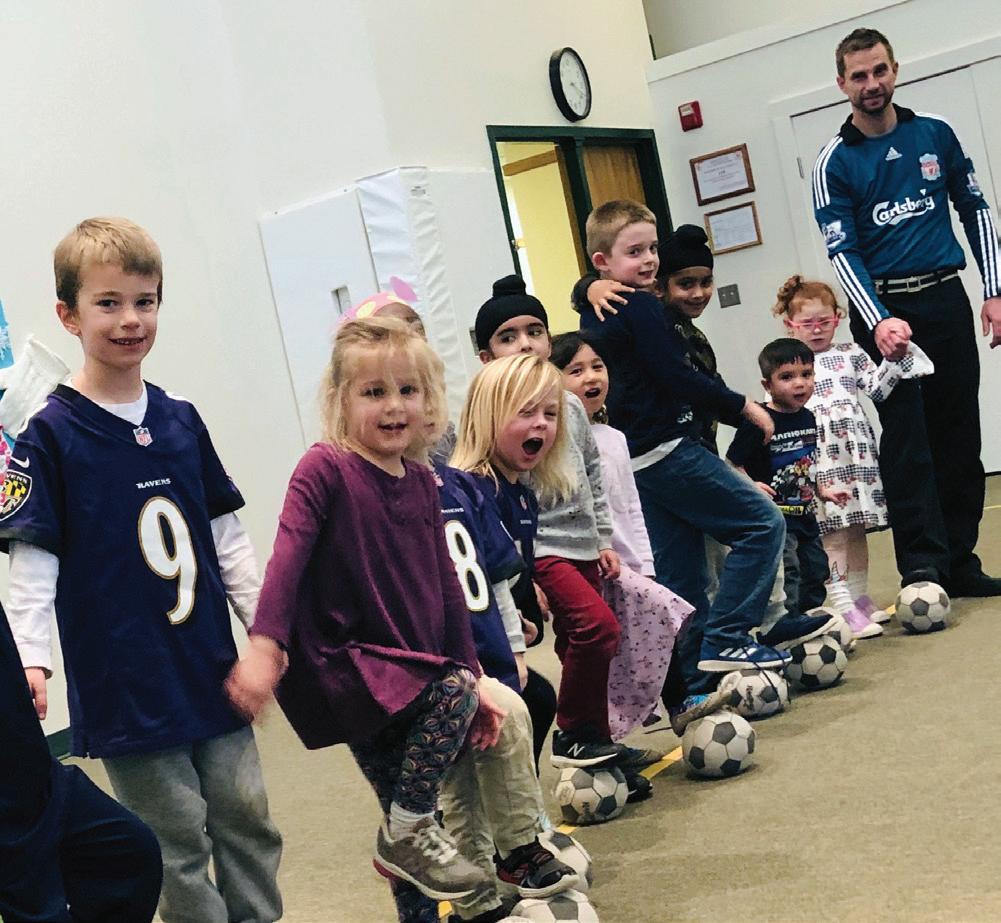
“Our mission at USTA Mid-Atlantic Section is to promote and develop the growth of tennis. We offer our tennis enrichment program because so many children have historically not had the chance to try out this fun lifetime sport. Our programs provide a pathway to a positive outlet, develop healthy habits, and teach children vital life skills and character development. It is great to see many more kids stay active through our sport, and we hope that it can be something they enjoy for many more years in the future.”

Alex Chan USTA TENNIS
a mine demonstration. Math Olympiad offers students an opportunity to join 150,000 students nationwide to work through engaging and challenging math problems. Students come together for practices throughout the school year to prepare for five Olympiads that are given October through March.
After-school classes provide an avenue for students to tap into their interests, learn a new skill, or practice developing one, in a multimodal class that helps develop the child as a whole. Courses span several grade levels. Because of this, students work alongside and collaborate with peers of different ages. Younger students gain self-confidence and maturity while older students learn to be positive
role models, and it forms a sense of community. Silver Knights Enrichment’s chess class, for example, is offered to students in kindergarten through eighth grade. This helps students grow not only academically, but socially as well, as friendships are formed across grade levels. Many of the After-School Enrichment classes revolve around non-traditional teaching methods, which helps students learn in a creative and hands-on atmosphere that is both extremely fun and educational. These classes offer much more than just the subject being taught. Many of the parents with their children in an ASE class have commented that they wish they could take the courses themselves!
AN OLD FRIEND GETS A NEW LOOK
Anne Wooleyhand, HEAD OF THE LOWER SCHOOL
The newly-renovated Lower School gym is open for business! On any given afternoon, it’s not unusual for students to be in the brand-new Exploratorium taking classes in yoga, karate, ballet, or even cake decorating.
The metamorphosis is due in large part to the vision and generosity, of parents Karen Stoddard and Eileen O’Neill (Quinn ’19.) The StoddardO’Neills had a vision for the space and actively partnered with GCS to reimagine the gym and Exploratorium as a holistic gathering spot and athletic center for students and teachers. “Eileen and I saw a clear need to not only renovate but genuinely reimagine what the gym could be for GCS. We took the initiative to step forward and provide the necessary funding that would make our proposal a reality,” said Stoddard.
The Exploratorium is a renovation of the old gym lobby and porch into a beautiful glass space where students and teachers enjoy a wide variety of activities and social gatherings. The gym has a new roof and foyer, renovated locker rooms, and a dedicated area with a slide and stairwell that has been enjoyed by students and teachers alike. Doors, flooring, and sidewalks, along with new blackboards, scoreboards, lighting, padding, and a projector and screen, were upgraded as part of the renovation. Previously, there was no air conditioning in the gym. Through the generosity of the Stoddard-O’Neills, a new heating and cooling system was also installed.
Head of School Greg Ventre is thrilled with the facelift as well. “Not only has the Stoddard-O’Neill family been one of our most generous supporters over the last decade, but their vision and generosity have enabled GCS to resuscitate a building that has great meaning to our alumni and community. It’s wonderful to see it re-vitalized into a new recreation center that can be enjoyed by everyone. We can’t thank them enough.” MIDDLE SCHOOL


From top: Karen Stoddard, Eileen O’Neill, and Quinn Stoddard-O’Neill ’19; Exterior of the Exploratorium; Rocco Peluso ’20; Elliot Quigley ’29, Alysa Dhillon ’29, Ava Richardson ’29, Morgan Roscoe ’29, and Ara Ghahremani ’29



